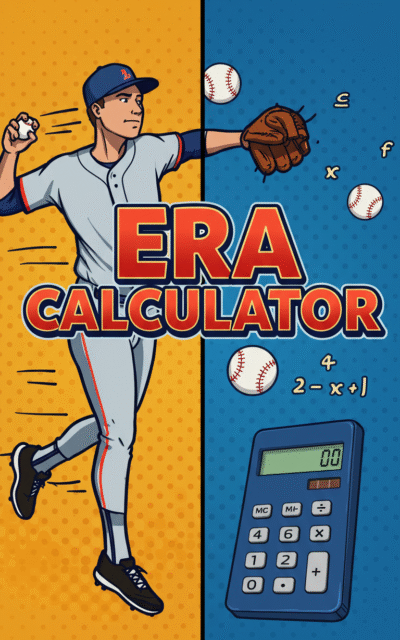ERA Calculator
Calculate a pitcher's Earned Run Average (ERA) with precision. This simple baseball stat tool helps coaches, players, and fans quickly determine pitching performance by converting earned runs and innings pitched into the standard ERA metric.
Guide
What is an ERA Calculator?
An ERA Calculator is a specialized tool that computes a pitcher’s Earned Run Average (ERA) in baseball. ERA is a key statistic that measures a pitcher’s effectiveness by calculating the average number of earned runs they allow per nine innings pitched. Lower ERA values indicate better pitching performance.
How ERA is Calculated
The ERA calculation follows a simple formula:
ERA = (Earned Runs ÷ Innings Pitched) × 9
| Component | Description |
|---|---|
| Earned Runs | The total number of runs scored against a pitcher, excluding runs scored due to defensive errors |
| Innings Pitched | The total number of innings a pitcher has completed |
| Multiplier (9) | Standard number of innings in a regulation baseball game |
Why ERA Matters
ERA is one of the most widely used metrics in baseball to evaluate pitcher performance. It helps:
- Compare pitchers across different teams and leagues
- Evaluate a pitcher’s consistency and performance over time
- Guide decisions for team managers and fantasy baseball players
- Provide context for contract negotiations and player valuations
According to MLB.com, an ERA below 4.00 is generally considered good, while an ERA below 3.00 is excellent at the professional level.
How to Use the ERA Calculator
- Enter the total number of earned runs allowed by the pitcher in the “Earned Runs” field
- Enter the total number of innings pitched in the “Innings Pitched” field
- Click the “Calculate” button (or the calculation will process automatically)
- View your calculated ERA result in the output section
- Use the “Reset” button to clear all fields and perform a new calculation
Understanding ERA Results
| ERA Range | Performance Level |
|---|---|
| Below 2.00 | Exceptional (Cy Young Award contender) |
| 2.00-3.00 | Excellent |
| 3.00-4.00 | Above Average |
| 4.00-5.00 | Average |
| Above 5.00 | Below Average |
The Baseball Reference historical database shows that the all-time MLB career ERA leader is Ed Walsh with a remarkable 1.82 ERA.
ERA Calculator Use Cases
- Player Evaluation: Coaches and scouts use ERA to assess pitcher effectiveness
- Fantasy Baseball: Players use ERA to draft and manage their fantasy teams
- Statistical Analysis: Baseball analysts track ERA trends across seasons
- Player Development: Pitching coaches monitor ERA changes to evaluate training effectiveness
Limitations of ERA
While ERA is valuable, it has some limitations:
- Doesn’t account for defensive quality behind the pitcher
- Can be affected by the ballpark dimensions and conditions
- May require a large sample size for meaningful evaluation
- Should be used alongside other metrics like WHIP, FIP, and K/9 for complete assessment
FAQ
-
What is considered a good ERA in baseball?
A good ERA varies by competition level. In Major League Baseball, an ERA below 4.00 is generally considered good, below 3.00 is excellent, and below 2.00 is exceptional. In youth or amateur leagues, the thresholds might be higher due to different skill levels.
-
Why is my ERA calculator showing 'Infinity'?
Your ERA calculator might show 'Infinity' if you've entered 0 for innings pitched. Since ERA is calculated by dividing earned runs by innings pitched, you cannot have 0 innings pitched (division by zero). Make sure to enter an accurate, non-zero value for innings pitched.
-
Can ERA be a negative number?
No, ERA cannot be a negative number. Since it represents the average number of earned runs allowed per nine innings, the lowest possible ERA is 0.00, which happens when a pitcher allows no earned runs.
-
How is ERA different from FIP (Fielding Independent Pitching)?
ERA measures actual runs allowed, while FIP isolates factors a pitcher can control (strikeouts, walks, hit-by-pitches, and home runs) to estimate effectiveness independent of fielding. FIP attempts to remove defensive influence from a pitcher's performance evaluation.
-
Do relief pitchers typically have lower or higher ERAs than starting pitchers?
Relief pitchers, particularly closers and setup men who pitch in short bursts, often have lower ERAs than starting pitchers. This is because they can exert maximum effort for shorter periods, face fewer batters per appearance, and are often matched up against favorable batting matchups.
Install Our Extensions
Add IO tools to your favorite browser for instant access and faster searching
恵 Scoreboard Has Arrived!
Scoreboard is a fun way to keep track of your games, all data is stored in your browser. More features are coming soon!

